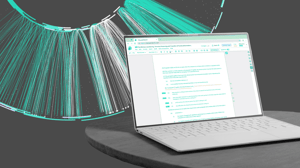When word processors reached offices in the early 1960s, they revolutionised document creation.
The IBM Selectric, the first typewriter to use binary coding, could produce several copies of a single document without the need for carbon paper or other fiddly processes. Unsurprisingly, it proved so popular it gained 75% of the market share in the US.
Subsequent innovations made drafting, editing, updating, and dissemination even simpler.
IBM's next model up from the Selectric, the MT/ST, had paperless storage at a time when computers were so big they needed their own room. The arrival of the personal computer and software like Word and Excel closed the circle, making the process fully digital.
But, then, something strange happened. It's like time stopped.
In 2020, technology has advanced by leaps and bounds. Yet, many businesses continue to rely on decades-old tools for business-critical functions like compliance.
In an increasingly regulated world, this attachment to old technology has made things more time-consuming, costly, and challenging than they have to be. With Covid-19 normalising remote working — and making the need for smart, connected documents more pressing than ever — could we finally be ready for another quantum leap?
Remote working: a tipping point?
"We're definitely moving towards more automation," says GRC expert Michael Rasmussen. "Organisations are getting frustrated with their current systems. They have dozens of policy portals and thousands of documents all over the place, and that doesn't help streamline workflows or promote organisational resilience in a world where many employees are now working from home."
To say Covid-19 — and the ensuing push towards remote working — has completely transformed the way organisations have to think about compliance is no understatement.
In April 2020, 49.2% of British workers reported working from home, up from just 5% in 2019. The numbers elsewhere tell similar stories. In the US, 42% of the workforce now works remotely full-time. And in the EU, home workers make up 40% of the workforce, up from 9% in 2019.
If keeping up with regulations and making sure everyone understands how to conduct themselves was hard in 2019, the difficulty factor has increased tenfold. Alongside ongoing regulatory change management projects and updates, there have also been a slew of regulatory changes in response Covid-19.
These changes have to be analysed and implemented and staff trained. But with most people working remotely, compliance teams can no longer simply gather people in a room and talk them through new policies and procedures.
"Fragmentation and silos are a huge drain on resources and a huge efficiency problem," says Rasmussen. "They also create issues of consistent culture, because policies are what guides and defines the way things are done in an organisation."
Changing tack: why now's the time to invest in tech
Covid-19's silver lining is that it has spurred organisations to update their systems and embrace new tech. Juniper Research reckons 40% of compliance spending — an estimated $115 billion by 2023 — has been earmarked for RegTech.
Rasmussen isn't surprised. If organisations were on the fence about technology, he argues, now is the time to take the leap.
"You've got lots of change happening because of COVID-19. Many organisations are considering shifting to remote work permanently, and that will require processes to be restructured.
"Security risk, corruption risk, fraud risk, harassment and discrimination risk… Remote working is going to create new challenges in all of these areas and policies and procedures have to reflect this if businesses are to stay resilient."
So what should organisations look to invest in?
"Firstly, I'd say collaborative authoring, because it makes it possible to have multiple people working on revising policies without having to check documents in and out. In a world where staff are disconnected from the office, we need a stronger culture. And strong policies are key to that."
Indeed, tech like ClauseMatch can help organisations create, edit, update, and disseminate new policies much faster, reducing the number of steps in the workflow and slashing costs by up to 30%.
But artificial intelligence and machine learning will also have a greater role to play moving forward.
"I think organisations that are able to get to the meat of new regulations fast and streamline regulatory change management are going to have a huge advantage moving forward.
"Technology will enable them to adapt more quickly in an environment of constant change and create an effective system of record… a clear audit trail they can use to show regulators that staff have received appropriate training and understand their policies and procedures."
Looking ahead: the market leaders of the future have smart, connected documents
If the past six months have taught us anything, it's that change is the only constant in an ever shifting world — and this will be so for many years to come. The good news is that those who are most resilient and adaptable will reap huge rewards. And that's why embracing smart, connected technology is so important.
"If it takes a human 200 hours to put together a report on policy compliance, it will only be feasible to do it occasionally… say once a year," concludes Rasmussen. "But if all this information is integrated in a common architecture that reports at the push of a button, you don't have those same constraints. The right technology makes you more efficient, effective, and agile."
With business dynamics changing from one minute to another, that's an advantage organisations shouldn't miss out on.
Want to learn more about the next wave of digitalisation and how this will make compliance smarter, faster, and more efficient?
Sign up to our FREE webinar: The Future of Compliance is Digital, Connected, and Automated
